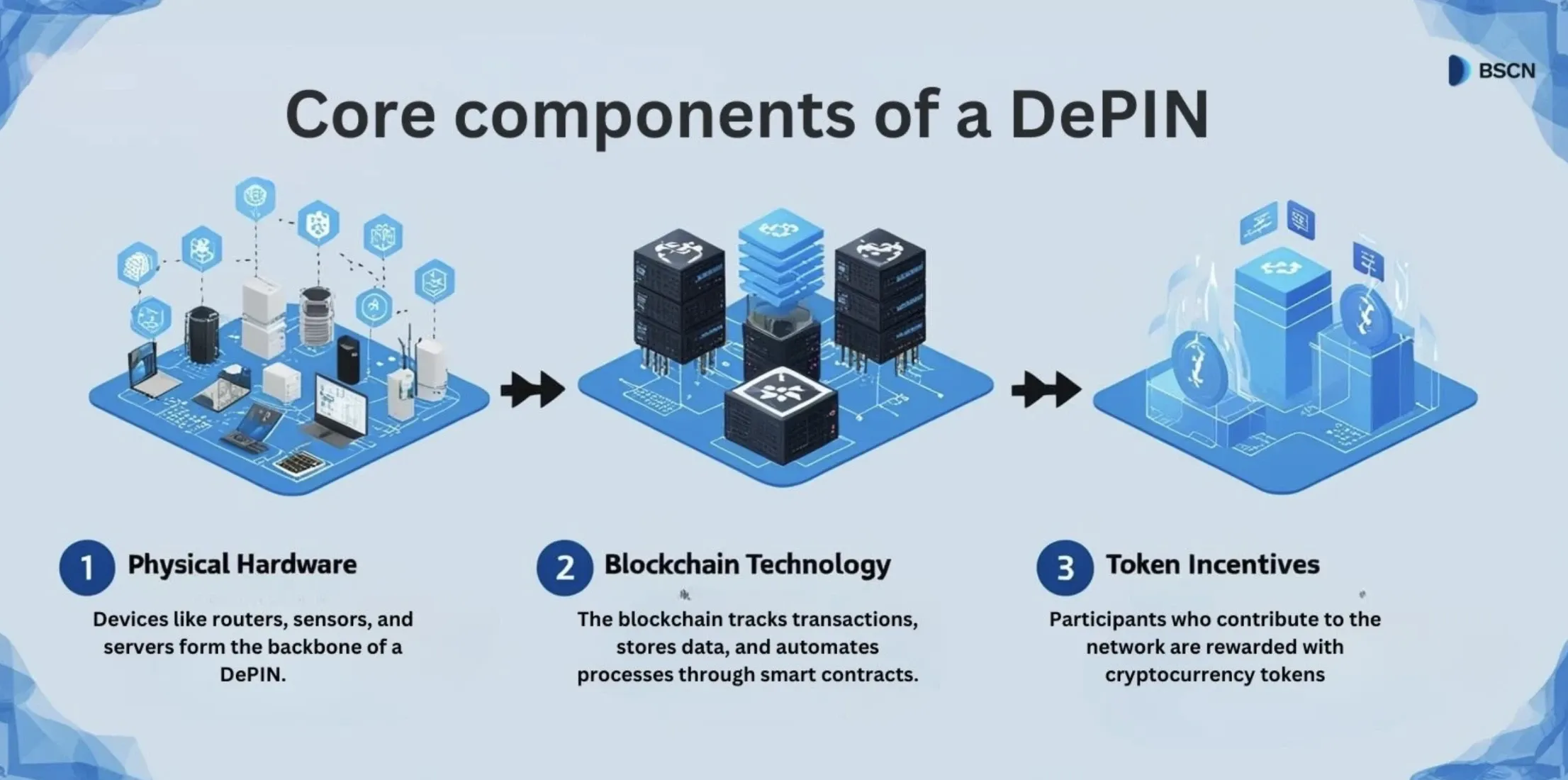Deepdive
(Advertisement)
What Is DePIN? Ultimate Guide to Decentralized Physical Infrastructure Networks

One of the hottest sectors in crypto. Learn what a DePIN is and how Decentralized Physical Infrastructure Networks use blockchain to manage resources like storage, connectivity, and energy.
Miracle Nwokwu
March 7, 2025
(Advertisement)
Table of Contents
What is a DePIN?
Decentralized Physical Infrastructure Networks (DePINs) connect the physical and digital worlds by using blockchain technology. They reward participants with tokens for offering services that are publicly recorded on the blockchain.
Picture a DePIN as a collaborative system, similar to a public library. In this scenario, blockchain acts as a detailed catalog, keeping track of every book’s location and lending history. It’s open for anyone to use. Just as libraries rely on the participation of readers, DePIN projects thrive on the collective contributions of their users.
DePINs enable networks of physical resources—such as WiFi or data storage—allowing individuals to share these resources directly with others without needing a middleman.
How Does DePIN Work?
While WiFi signals and data might seem digital, they depend on physical components like routers, servers, and antennas. These devices form the foundation of the network, making them part of the physical infrastructure.
DePINs operate on blockchains and utilize tokens or cryptocurrencies for transactions. This ensures transparency and traceability. Users who contribute resources, like hosting a wireless hotspot or providing storage, are rewarded with tokens.
The blockchain serves as a virtual manager, recording every action, such as service exchanges and network updates. This open system allows anyone to participate in offering services, like internet access or energy management, without needing special approval.

Why Are DePINs Important?
DePINs make infrastructure like energy systems, communication networks, and transportation more accessible, efficient, and adaptable. Unlike traditional systems controlled by large corporations, DePINs distribute control among everyday participants. This allows smaller groups or individuals to manage resources like electricity, internet, or storage.
They also enhance reliability by remaining operational even during crises. Their decentralized nature promotes competition, reduces costs, and encourages innovation. Additionally, DePINs eliminate the need for significant upfront investments, allowing for quicker implementation and customization for local needs. This approach levels the playing field for small businesses and entrepreneurs, creating new opportunities to offer services.
Components of a DePIN
DePINs rely on three primary components:
- Physical Hardware: Devices like routers, sensors, and servers form the backbone of a DePIN. These physical nodes connect the digital blockchain to the real world.
- Blockchain Technology: The blockchain records all activity, ensuring transparency. It tracks transactions, stores data, and automates processes through smart contracts.
- Token Incentives: Participants who share resources or contribute to the network are rewarded with cryptocurrency tokens, motivating them to maintain and expand the system.
For example, smart contracts and Internet of Things (IoT) devices automate tasks such as energy distribution or data collection. These systems ensure efficiency and eliminate the need for intermediaries.
Traditional Infrastructure vs. DePINs
Traditional infrastructure is typically centralized, controlled by a single entity or corporation. This approach can lead to inefficiencies, high costs, and limited access. DePINs, on the other hand, distribute ownership and management, enabling direct collaboration between users and providers.
Examples of DePIN Use Cases
Storage Solutions
DePINs create decentralized storage networks by distributing data across multiple devices. This makes data storage more secure and reliable compared to centralized systems. Projects like Filecoin break data into smaller pieces, distribute it across the network, and use encryption to keep it safe and accessible.
Wireless Connectivity
DePINs offer peer-to-peer wireless networks where devices communicate directly. Projects like Helium let individuals set up hotspots to provide IoT connectivity. In return, they earn cryptocurrency. This model reduces the need for centralized hubs and fosters innovation in areas like agriculture and logistics.
Energy Distribution
DePINs can power local microgrids with renewable energy, like solar panels. Excess energy can be stored in nearby batteries and distributed during high-demand periods. These systems support green energy initiatives and improve overall reliability. Smart grids help balance energy supply and demand in real-time.
Decentralized Sensors
DePINs also use distributed sensors to monitor things like traffic, environmental conditions, or infrastructure health. Each sensor collects and securely shares data across the network. Participants who provide data can earn cryptocurrency rewards. This decentralized data collection benefits urban planning, farming, and environmental monitoring.
Steps to Build a DePIN
Creating a DePIN requires careful planning and execution. Here’s a step-by-step outline:
- Define Objectives: Clearly outline the goals of your DePIN, such as improving energy efficiency or expanding internet access. Identify the specific type of infrastructure you want to focus on.
- Choose a Blockchain Platform: Select a blockchain that meets your needs in terms of scalability, speed, security, and cost. Consider platforms that have robust features and strong governance models.
- Establish a Token Economy: Design a token system to handle transactions and rewards. Create a governance mechanism, such as token-based voting, to include stakeholders in decision-making.
- Develop Smart Contracts: Build secure and transparent smart contracts to automate transactions and manage resources efficiently. Test them thoroughly to ensure reliability.
- Deploy Hardware: Set up the physical infrastructure, such as sensors, routers, or smart meters. Ensure these devices integrate seamlessly with the blockchain.
- Attract Participants: Gather a mix of resource providers and users. Use token rewards or revenue-sharing models to encourage participation and grow the network.
- Implement Security Measures: Protect your DePIN with encryption and security protocols to safeguard data and prevent unauthorized access.
Challenges and Drawbacks
While DePINs offer many benefits, they also come with challenges:
- Regulatory Hurdles: Many countries lack clear legal frameworks for blockchain and crypto-based projects. Staying compliant with existing laws is essential.
- Security Risks: Decentralized systems must balance transparency with privacy. Smart contracts and sensitive data can be vulnerable to cyber threats if not properly secured.
- Complexity: Managing physical devices and integrating them with blockchain technology can be technically demanding, requiring significant expertise and resources.
DePINs are reshaping how infrastructure works by decentralizing control and encouraging collaboration. They open the door to innovative solutions for storage, connectivity, energy, and beyond. While challenges exist, the potential for accessible and efficient systems makes DePINs a promising option for the future of physical and digital integration.
Read Next...
Disclaimer
Disclaimer: The views expressed in this article do not necessarily represent the views of BSCN. The information provided in this article is for educational and entertainment purposes only and should not be construed as investment advice, or advice of any kind. BSCN assumes no responsibility for any investment decisions made based on the information provided in this article. If you believe that the article should be amended, please reach out to the BSCN team by emailing [email protected].
Author
 Miracle Nwokwu
Miracle NwokwuMiracle holds undergraduate degrees in French and Marketing Analytics and has been researching cryptocurrency and blockchain technology since 2016. He specializes in technical analysis and on-chain analytics, and has taught formal technical analysis courses. His written work has been featured across multiple crypto publications including The Capital, CryptoTVPlus, and Bitville, in addition to BSCN.
(Advertisement)
Latest News
(Advertisement)
Crypto Project & Token Reviews
Project & Token Reviews
Comprehensive reviews of crypto's most interesting projects and assets
Learn about the hottest projects & tokens













